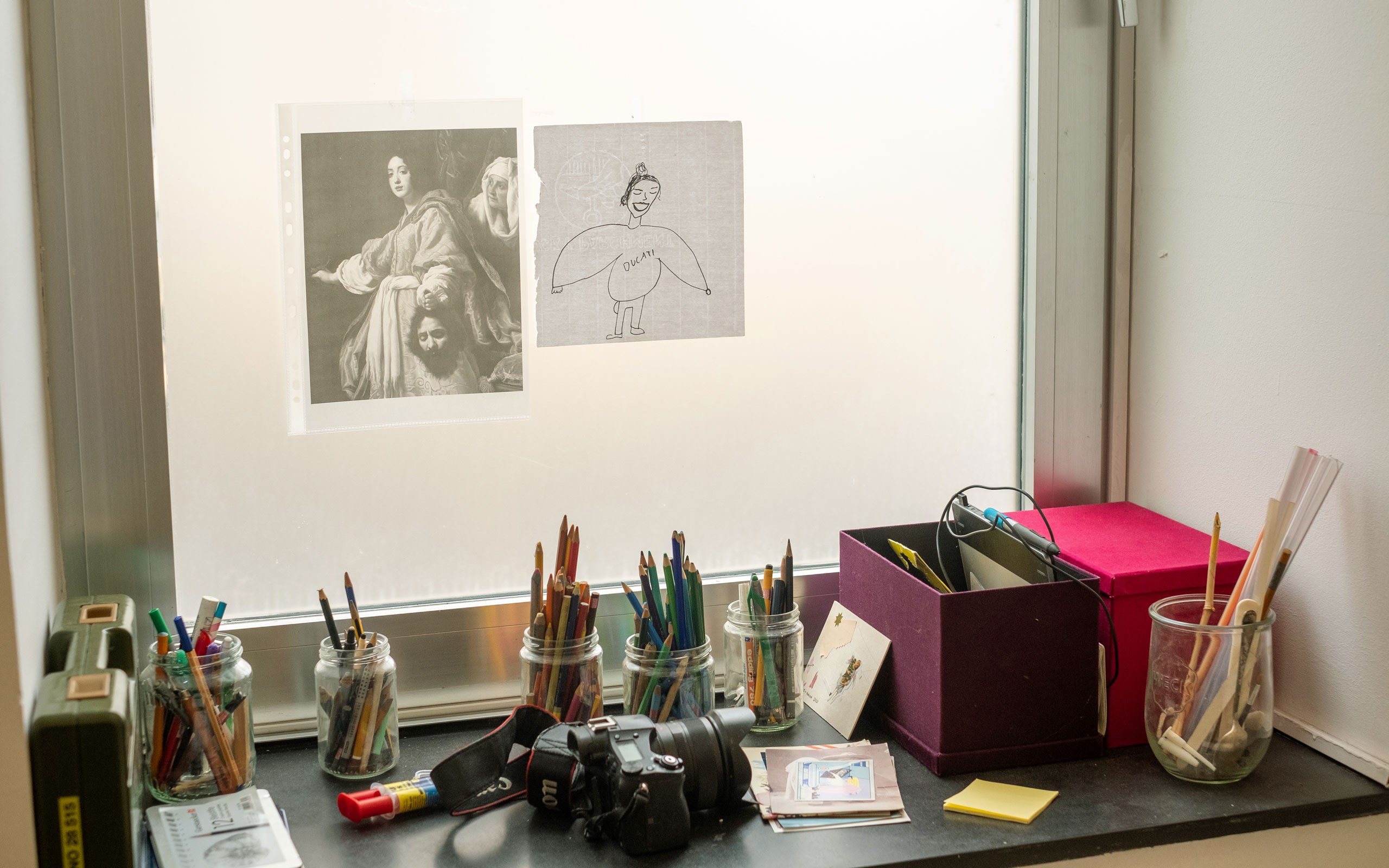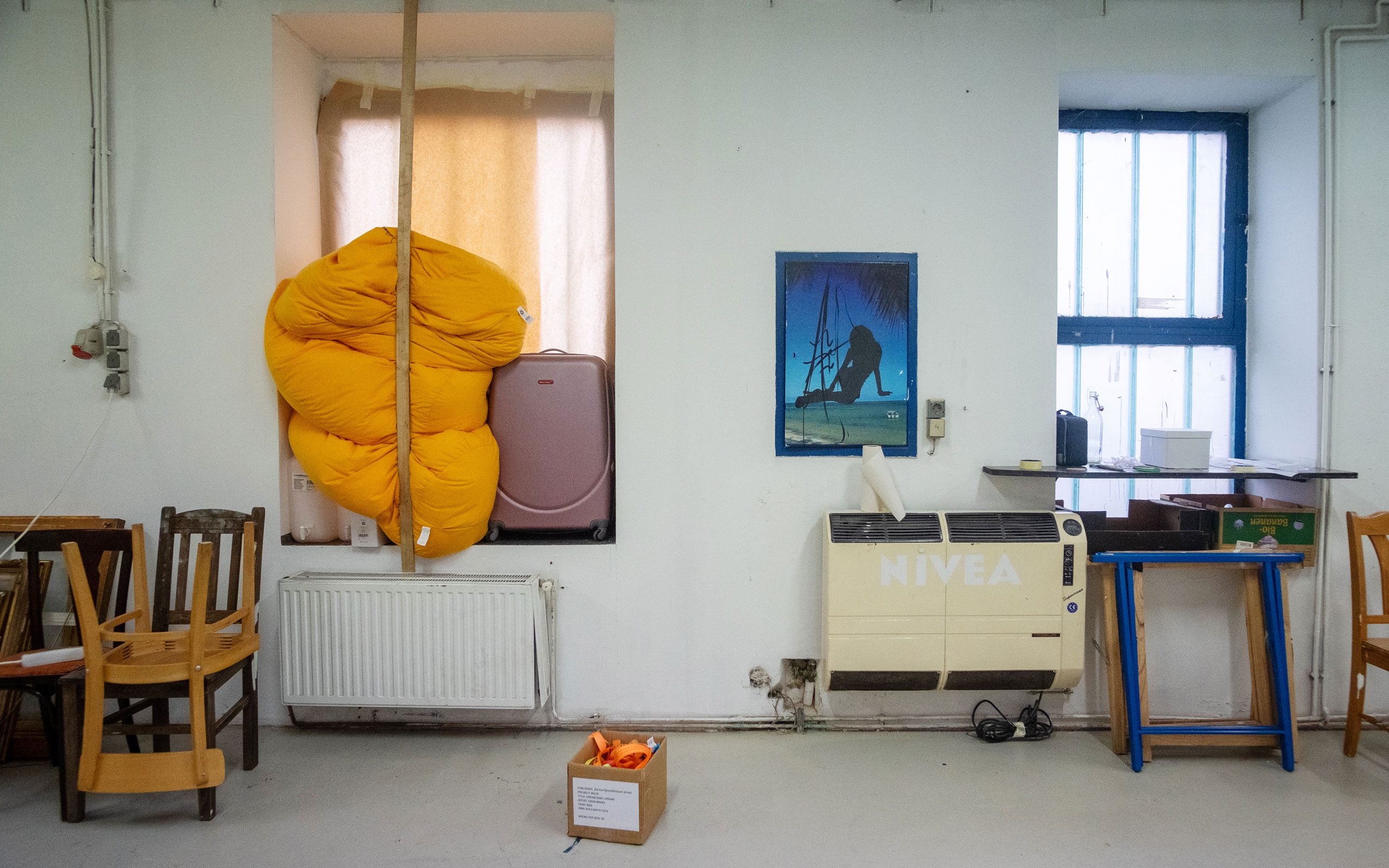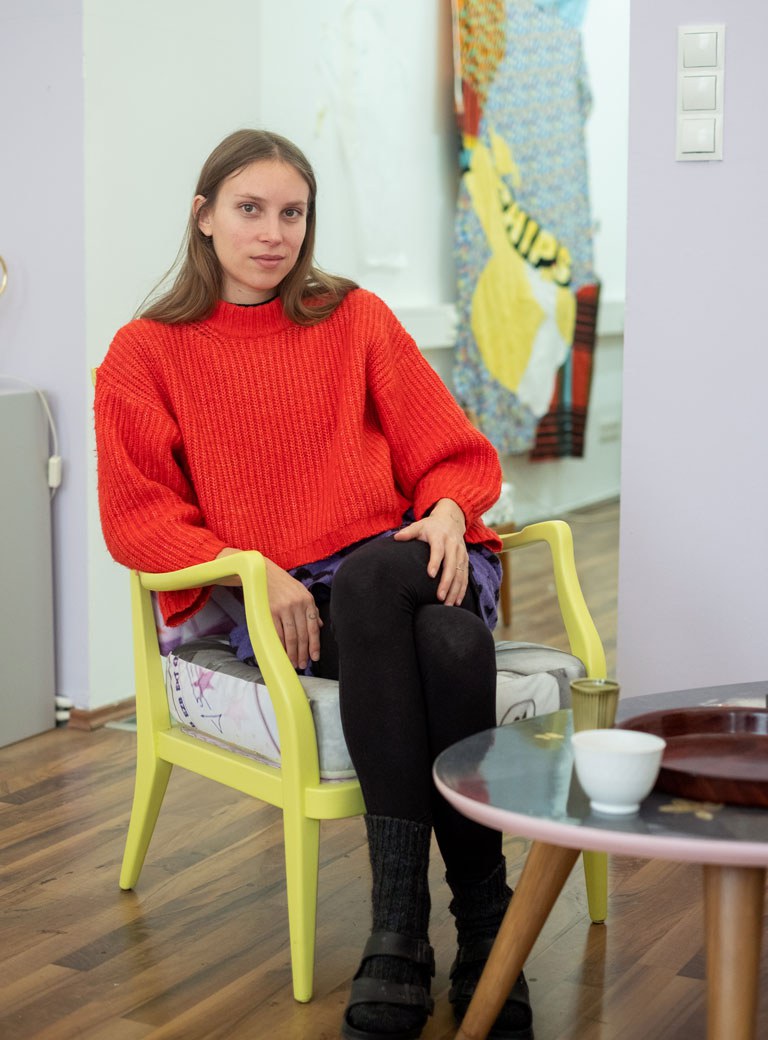In her colourful and complex collages, visual artist Nana Mandl merges analogue and digital images to create multi-layered works of art. By incorporating elements from both personal memories and collective cultural references, Mandl’s works bridge the gap between individual experiences and broader societal narratives. The tactile nature of her art, including embroidery and textile manipulation, serves as a contrast to rapid digital image production. In this way, Mandl offers a unique perspective on the intersection of personal and cultural memory in the digital age.
Nana, how would you describe your work to someone who knows nothing about it?
I produce mixed-media work; I come from a classical painting background, but I actually like to mix abstract and figurative elements. I’m also very much interested in mixing materials when creating the images. And what I’m also interested in are installation situations, in other words really using an entire room, working with the floor and the wall, but also elements such as furniture and fashion. I’m interested in a flood of images and sometimes elements of a digital aesthetic, an overstimulation or a simultaneity of things, those are the themes.
How did your interest in art begin?
From a very early age, I can’t remember a time when I wasn’t interested in it. I was always drawing, painting, or doing handicrafts, but also decorating ... My parents simply encouraged me very early on. I didn’t have any role models, there were no artists in our circle of friends, so it wasn’t necessarily a profession that I thought I could do, but my parents always told me, no, no, you’re going to be an artist. (laughs)




You studied at the Kunsthochschule Berlin-Weißensee and received your diploma in Fine Arts from the University of Applied Arts in Vienna. How did these schools and places influence you artistically?
I have the feeling that my year in Berlin was more formative and I learned more there than in the five years I spent in Vienna, simply because there was this willingness to engage in discussion, even among the very young students. There was a kind of feedback culture that I really miss in Vienna. Even when I talk to students now, I notice that it’s still the same, there’s a lack of candour which is not inherent as it is in Berlin, where it is the norm to talk about one’s work in an objective way.
So, Berlin gave you good tools for your artistic development?
Yes, or rather a good examination of the content. What has stuck with me is concentration on the essentials, what are the individual pictures about, what is a new aspect, and then perhaps combining these rather than getting into this repetition again and again, i.e., I don’t need to exhibit three works that say the same thing, especially when it comes to a limited space.
Did you really want to study in Vienna?
It was the obvious thing to do. I grew up in London. For me Graz was actually this village that was somehow really awful, so it was logical to go to Vienna. I was actually drawn to Paris for a while, but the entrance exams there were very early in the year, and I missed them. Therefore, I applied to Vienna and was accepted.
Vienna is now your base. How do you perceive the scene, what potential does the city have for you?
I’ve become a loner and I’m not really up to date with everything that’s happening, but it’s definitely very easy to live here as a young artist; there’s money, there are opportunities, you can network very quickly because it’s quite a small and manageable scene, and it offers you a lot of opportunities right from the start. I remember when I came to Berlin and many people were surprised that I had already sold works. In Vienna, that was quite normal, even at the beginning of my studies, where you already had collectors and exhibited. But more could simply happen, including initiatives for artists’ residences that last, like the WUK. I find it demotivating when nothing lasts.




You deal with floods of images, including those from the digital media. Where does this interest come from; how did it develop?
I made a lot of digital sketches for painting building up a digital archive only to realise that, on the one hand, there is an aesthetic that only unfolds in the digital realm and can’t be implemented in painting, and on the other hand, it seemed absurd to copy it when it is actually the material itself that I want to use. So, I was interested to combine different stories and images; I saw images and felt I wanted to work with them. And I didn’t want to defamiliarise them, but actually take them and place them in a composition with other images or with other spheres.
What is the next step in the process?
This constant searching results automatically in a flood of images; one is already completely overloaded when moving around in the digital world. In addition, there’s a juxtaposition, a discrepancy between the mundane and the super-private; this is very much reflected in digital media, from news from all over the world to personalised ads. Or the fact that all tabs on your computer are always open and overlap and exist simultaneously ... I’m fascinated by all of this, and it appears repeatedly in my works, a kind of layering or superimposition, but there’s also a juxtaposition or a superimposition of things. And the attempt to make this tangible through bringing it into the material and thus making it visible, along with the question of how it can all exist at the same time, including all of these themes.
So, it is a translation of digital topics into an analogue world of experience?
Yes, it is. I often toy with the idea of whether it could stay in the digital realm, but that just wouldn’t be satisfying for me. As a haptic person, it’s not my tool or my approach to leave it there. I need the contrast, because the preternaturally slick Photoshopped surface holds many reservations for me, and it does not represent my approach to the world. I’m really interested in the transformation into something that’s not smooth but has haptic and other tangible qualities.


In many of your collages, you use materials such as old stickers that may be reminiscent of your own youth, and also fabrics. How do you find them?
Everywhere. I am definitely a collector. On the one hand, I have my digital archive, which has dwindled in recent years, and then there’s an embroidery collection from the 1980s and 90s, partly sourced from my sisters, but also from me, and then just all kinds of magazines, i.e., pictures that I find and cut out and save. There are also things that I find on the street or that somehow come to me ... The fabrics are also very diverse. Sometimes I use things that I already have, old clothes that I no longer wear, but where the fabrics are quite interesting, or I buy something. It’s a collection from everywhere. I also notice that before I throw things away, I first analyse what I can still use in order to find small elements that I can incorporate into my sculptures.
How do you go from your collection to a complete work?
Often a picture speaks to me strongly; I rarely start with a white canvas. But rather with a textile, an image ... that’s where I start from and then it is also a question of where I am at that moment whether it will be a collage and remain on this paper level or whether it will perhaps be transformed into something material. There are themes and forms that interest me, which I then combine in different ways, including how I abstract something or leave it out; this is how a picture is created piece by piece.


You once said that art shouldn’t just stay on the wall, but should be integrated into everyday life ...
I think it's a shame when art doesn’t become part of everyday life. I’m fascinated by other people who at home, have such small and simple arrangements; it’s a kind of mindfulness in dealing with the world we live in. And you can cover everything with art, it’s not just about pictures on the wall, but also chairs or upholstery. I think it’s nice when it's integrated in this way and not everything is limited to functionality.
Your works really do appear very playful and inviting; is interaction desired in the exhibition context?
It definitely gives me great pleasure when that happens. But I notice that people are inhibited. It is exciting to make objects that can be used and at the same time bridge the gap between the uncertainty of the question, can I sit on the chair or is it an art object? Or the bag, can I use it or is it actually that was placed there? I like this game and its ambiguity, because sometimes even I as the artist am not entirely clear about it, because for me it is often both.
Is there something you want people to see, feel or experience?
No. (laughs) I always find it very exciting to learn what people hear, what they see, feel, and experience, and if that coincides with how I feel, I feel very substantiated. That’s why I find art so exciting, that there is this freedom and these possibilities for interpretation. And the way I work, with many different materials, media, and images, it leaves a lot of room for interpretation and stories. And it also changes over the years, even compared to my own work, because suddenly I have completely different associations, if only because in the meantime I have changed.
Alongside sculpture and collage, poetry also plays a major role in your work …
I see text as an extension of the painterly space. It started at the very beginning of my studies, when I found for example, that one needed an artist statement, which had to be expressed through the structured system of language. Many artists struggle with this, with the question: I paint, how should I translate this into a language? I figured I didn’t want to see it as something that describes what I do, but rather as something that expands it or that I might not be able to express so much in my paintings, but that still occupies me. So, a new aspect emerged through writing. My poems do deal with serious themes, but not in a suffering tone; it’s more a light way of dealing with text and having a playful approach, which I’ve been trying to find for a long time and have now found.

You are also a founding member and contributor to the internationally active artists’ collective CLUB FORTUNA. What are your aims?
Xenia Lesniewski set it up with the idea of simply having fun and creating something together that is totally free and that we learn to deal with exhibition concepts in a much more interactive way. In the beginning there were five of us, different artists who work very differently, but it has always been fruitful. Over the years there have always been changes, but a signature has developed. We are interested in creating interactive situations, because one can’t work performatively on one’s own, but in a collective and in this protected framework, much more is possible, including much larger and conceptual projects.
So, the collective doesn’t stand in your way as an artist?
It does with regard to time, (laughs). At the moment there are four of us and three have children; balancing your own artistic work, collective work, and everything else is often quite challenging. But apart from that, I feel that everyone contributes well, each with her own aesthetic and approach. And that it tends to become something new avoiding intrusion on each individual’s work, otherwise it wouldn’t be any fun at all.
What motivates you to keep going?
There is an inner drive to create, to try to understand things. I recently had a conversation about the juxtaposition of science and art and there was this moment where it appeared to me that it is actually very similar, because it is all about this not understanding or not knowing and creating something new out of this nothingness or empty space. I actually find it really nice to start from this description of art, because I have the feeling that it is not just about the will to produce, but actually about exploring something. I think there is nothing more boring than a repetitive process, as once I have mastered a painting, I repeat again … One can do that for a certain amount of time, but then it becomes endlessly boring. For me, that is not the point of art, to find just one technique or method and then stay there endlessly. It is about keeping seeing new things and exploring new spheres.

You have a solo exhibition at Galerie Kandlhofer in the fall. What will it be about?
At the moment I’m mainly working on textile pieces with a technique that traditionally has very feminine connotations. The motifs are almost exclusively mirror selfies of mothers with their children. I do have a fantastic collection of images from my private environment. This relatively new form of self-portrayal fascinates me immensely, especially on social networks. After all, the moment is captured in order to share it. This moment in which we feel sexy, the outfit fits, the look or whatever... On the other hand, I find these pictures exciting because as a mother one totally disappears in our society. Suddenly nobody looks at you any longer, you are just a service provider, dedicated to child and family care. And dare you go out in the evening with your baby or child: it’s almost outrageous. There are so many facets of motherhood that interest me in this very unequal world. I therefore see these images as subtle opportunities for self-empowerment. This empowerment will be the main focus of the exhibition, both in the form of images and text.

Pop up installation, Vienna 2024 © Nana Mandl

the happy days are over, my friend, embroidery, fabrics, acrylics, paper and digital print on canvas

witchcraft media, mixed media on canvas, detail, 2020

shopping mall selfie, textiles and embroidery on canvas, 2023
Interview: Marieluise Röttger
Photos: Maximilian Pramatarov






